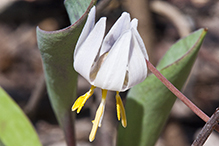white trout lily
(Erythronium albidum)
Conservation • Wetland • Description • Habitat • Ecology • Use • Distribution • Taxonomy
Description |
||
White trout lily is a 4″ to 8″ tall, erect, perennial forb rising from a short, vertical, thickened, underground stem (corm). It is usually found in large colonies. Less than 1% of the plants in a colony will flower in any given year. Most plants are one-leaved and nonflowering. Flowering plants have two leaves. The leaves appear to originate at the base, but they actually originate below ground, about halfway up the underground stem. They are arranged in pairs but are not exactly opposite. They are 3″to 8½″ long, lance-shaped, untoothed, fleshy, green, flat, mottled or spotted with silver, and covered with a whitish, waxy coating. The inflorescence is a solitary flower hanging downward at the end of a stout, nodding stem. The stem is 4″ to 6″ tall, hairless and leafless. The flower has is nickle-size or larger. It has 3 petals and 3 identical-looking sepals, collectively called tepals. The tepals are 1″ to 2″ long, lance-shaped, white or bluish-white, and yellow at the base on the inside. They flare outward, extending nearly to the horizontal, eventually curving backward. The anthers and filaments are yellow. The fruit is an oblong to egg-shaped, 3-celled capsule, ⅜″ to ¾″ wide. It is held erect at maturity. |
||
Height |
||
4″ to 8″ |
||
Flower Color |
||
White or bluish-white |
||
Similar Species |
||
Minnesota dwarf trout lily (Erythronium propullans) is a rare, much smaller plant, 1½″ to 4″ in height. The leaves are 1½″ to 5″ long. The tepals are about ½″ long. The filaments are white. Almost all of the plants in a colony will flower each year. Yellow trout lily (Erythronium americanum ssp. americanum) has yellow flowers. The fruit is held off the ground horizontally. |
||
Habitat |
||
Moist. Woods, forests. |
||
Ecology |
||
Flowering |
||
Apri to May |
||
Spring Ephemeral |
||
White trout lily is a true spring ephemeral. All of the parts of the plant that are above ground will have disappeared by the time the forest canopy has developed in June. |
||
Pests and Diseases |
||
|
||
Use |
||
|
||
Distribution |
||||
|
Sources |
|||
| 6/29/2022 | ||||
Nativity |
||||
Native |
||||
Occurrence |
||||
Common |
||||
Taxonomy |
|||
| Kingdom | Plantae (Plants) | ||
| Division | Tracheophyta (Vascular Plants) | ||
| Subdivision | Spermatophytina (Seed Plants) | ||
| Class | Liliopsida (Monocots) | ||
Order |
Liliales (lilies, supplejacks, and allies) | ||
Family |
Liliaceae (lilies) | ||
| Subfamily | Lilioideae | ||
| Tribe | Tulipeae | ||
Genus |
Erythronium (fawn lilies) | ||
Some sources, including GRIN, place the genus Erythronium in the tribe Lilieae. Other sources, including iNaturalist, separate Erythronium with the genus Tulipa and six other genera into the tribe Tulipeae. |
|||
Synonyms |
|||
|
|||
Common Names |
|||
blonde-Lillian small white fawnlily white dog-tooth-violet white fawnlily white trout lily |
|||
Glossary
Filament
On plants: The thread-like stalk of a stamen which supports the anther. On Lepidoptera: One of a pair of long, thin, fleshy extensions extending from the thorax, and sometimes also from the abdomen, of a caterpillar.
Sympatric
Referring to closely related species that have ranges that overlap but which do not interbreed.
Tepal
Refers to both the petals and the sepals of a flower when they are similar in appearance and difficult to tell apart. Tepals are common in lilies and tulips.
Visitor Photos |
|||||
Share your photo of this plant. |
|||||
| This button not working for you? Simply email us at info@MinnesotaSeasons.com. Attach one or more photos and, if you like, a caption. |
|||||
Nancy Falkum |
|||||
 |
 |
||||
MinnesotaSeasons.com Photos |
|||||
Habitat |
|||||
 |
|||||
Plant |
|||||
 |
 |
||||
 |
 |
||||
Flower |
|||||
 |
 |
||||
 |
|||||
Leaf |
|||||
 |
|||||
Fruit |
|||||
 |
 |
||||

Visitor Videos |
|||
Share your video of this plant. |
|||
| This button not working for you? Simply email us at info@MinnesotaSeasons.com. Attach a video, a YouTube link, or a cloud storage link. |
|||
Other Videos |
|||
| MyNature Apps; Identifying Trout Lily, Erythronium albidum MyNatureApps |
|||
About
Uploaded on Apr 29, 2011 Identifying a Trout Lily, Erythronium albidum. Brought to you by MyNature Apps www.mynaturesite.com |
|||
| Trout Lily Part 3 NewCultureEarth |
|||
About
Published on Mar 28, 2012 This video was uploaded from an Android phone. |
|||

Visitor Sightings |
|||||
Report a sighting of this plant. |
|||||
| This button not working for you? Simply email us at info@MinnesotaSeasons.com. Be sure to include a location. |
|||||
| Nancy Falkum 5/6/2022 |
Location: Whitewater WMA, Main Branch Unit |
 |
|||
MinnesotaSeasons.com Sightings |
|||||

|
Created: Last Updated: © MinnesotaSeasons.com. All rights reserved. |


